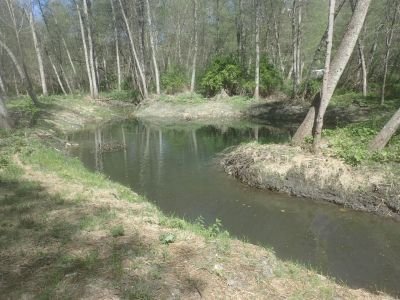The World According to Salmon
by James Peterson
In the world according to salmon, the rivers and streams dictate their choices in life. If the flows are
high and the water is cold, they are more likely to be able to complete their life cycles and ensure the future of their species in their offspring. If the flows are low and the water is warm, their chances of successfully surviving to spawn become much more challenging. As many of us along the River know, most salmon species die after spawning, and from the time they return to fresh water, their journey towards their natal streams will be their lives terminus. Their sacrifice and determination is almost Shakespearean in its tragedy and beauty.
Juvenile coho salmon rearing in ponds constructed along Middle Creek 6/7/2016.
After five years of intensive drought conditions, Northern California benefitted from a slight respite this year, and winter conditions were more along the lines of a normal weather pattern for this region. To give you an example of this, last year in mid-June (6/15/15) the Klamath River at Orleans was flowing at a rate of 2,250 cubic feet per second (CFS) and a temperature of 73 degrees Fahrenheit. This year mid-June (6/15/16) the river is flowing at 3,870 CFS and a temperature of 63 degrees Fahrenheit. To put that in context, one cubic foot of water is roughly equivalent to one basketball full of water per second. 71 degrees Fahrenheit is the beginning of the stressful temperature range for juvenile salmonids and over 75 degrees can be lethal.
Juvenile coho and Chinook in O’Neil Creek Pond.
The conditions this year are hands down a whole lot better than last year. For the past ten years, MKWC in partnership with the Karuk Tribal Fisheries Program, and various other state and federal agencies, have been constructing off-channel habitats along key tributaries to the Klamath River. Juvenile fish looking to escape high winter flows and stressful or even lethal summer temperature conditions in the Klamath River and its tributaries utilize these habitats in order to survive. Two of the newest constructed ponds along Middle Creek, a tributary to Horse Creek, have their first cohorts of juvenile coho salmon moving into them as creek flows begin to drop.
Many of these fish will stay in the ponds all summer and possibly even through next winter if they like the conditions. Fish utilizing these ponds have been shown to have a survival rate of two to six times higher than fish that don’t. To date, MKWC has constructed 12 off-channel ponds throughout the Klamath basin and all of them have seen use by juvenile and sometimes adult coho salmon. Some ponds even hold several thousand juvenile fish during parts of the year. Some fish that were marked as juveniles in these ponds have returned several years later as adults and been detected spawning in areas along Seiad Creek, showing that these ponds are beginning to produce adult fish! By the summer of 2017, several more of these ponds will be constructed as safe havens for these determined little fish to shelter in.
Goodman Pond constructed by MKWC in collaboration with the Karuk Tribe and other partners offers refuge from Middle Creek flows.
O'Neil Creek Pond.
These habitats along the margins of a stream may not look like much to a casual onlooker, but when your whole world revolves around survival against steep odds, these side-channel sanctuaries can make a big difference, and in the world according to salmon, every little bit helps.
James "Jimmy" Peterson is the Water Monitoring Coordinator at MKWC. He comes from Minnesota, and brings to the Middle Klamath a love for water and fish and a sense of stewardship for those resources that transcends borders.




